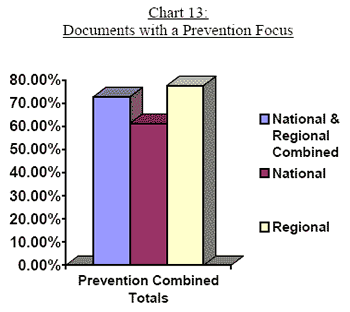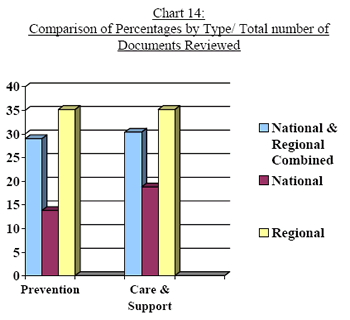Common menu bar links
E-mail this page
Evaluation of the Hepatitis C Prevention, Support and Research Program 1999/2000 – 2005/2006
Previous | Table of Contents | Next
5.2 Results and Achievements
5.2.1 Prevention and Community-Based Support
Progressively through the first five years, and more emphatically during the two extension years, the Program increased its strategic focus on vulnerable populations and the delivery of HCV prevention initiatives such as “harm reduction”. Vulnerable populations are defined as people who are “at risk of infections in addition to HCV (e.g., hepatitis A and B, sexually transmitted infections, tuberculosis and HIV)”, who “are grappling with multiple social and economic problems (e.g., homelessness, social isolation),” and who are not aware of the risks. In response to the Five-Year Program Review and to broaden the context by better leveraging resources and partnerships with other sectors and levels of government, “integrated and holistic” prevention and community-based support programming approaches were established. When asked, key informants confirmed: “Funding of prevention projects was a strong element in both renewals”.
On the subject of support, informants noted the federal role to provide support models and approaches, not fund or be directly involved in local level community support. For example, the national jurisdiction provided funding to national groups such as the Dieticians of Canada, Aboriginal Friendship Centres and the Consensus Conference on Viral Hepatitis, while the regions worked directly with communities. Some of the regionally based respondents commented on the problems with the support group model: support groups tended to be established for mainstream populations and it was questionable whether they were welcoming to the vulnerable, at-risk populations; and, eventually people lost interest – although they had wanted support groups initially, they ended up not coming. Ultimately, this precipitated the Program's shift to prevention and support projects.
 |
The document review provides a picture of this strategic shift (Chart 12). Chart 12 shows 59.8% of combined national and regional documents (165/276) dealt with support: building a thoroughly integrated approach; and emphasizing coordination, collaboration and integration across jurisdictions. Proportionately, support efforts were very similar, regardless of jurisdiction. |
 |
In comparison, Chart 13 illustrates, 72.8% of combined national and regional documents (201/276) dealt with prevention efforts by: creating hepatitis C awareness; building a more thorough understanding of harm reduction and placing greater emphasis on this concept; and placing greater emphasis on evaluating the long-term effectiveness and impact of activities for the prevention, care and treatment of hepatitis C. The document review also shows proportionately more prevention efforts at the regional level (77.6% or 152/196) than at the national level (61.3% or 49/80). Respondents supported these findings by commenting on how much more successful prevention projects were at the regional level where they were “innovative, street-level, hands-on, front-line”, focusing on IDU, street, Aboriginal and prison populations. |
 |
Chart 14 corroborates the greater focus of regional initiatives on prevention,care and support than at the national level. This is logical given the propensity of the Regions to fund multiple regional/local projects with multiple objectives. The percentages shown in Chart 14 are based on the total number of documents in the document review (combined=276, national=80 and regional=196).
|
To better understand the impact of the strategic shift, stakeholders and key informants were probed on the Program's implementation of new and/or innovative prevention and support projects. There were high levels of agreement on this issue (Table 3) with respondents specifically identifying the Program's work with CSC (e.g., needle exchange and tattooing program), the Mouse model (i.e., clinical/biomedical research for developing new treatments/vaccines) and the engagement of youth (e.g., Youth Planning Committee, particularly the symposiums/retreat).

While new/innovative prevention and support projects were identified as being important, one key informant noted the need to put “innovative” into context. “It was very difficult to be new or innovative; particularly during the extension years, the Program built-on what worked in the past.” Further, “it is questionable whether or not new and/or innovative projects are any more important than just doing outreach and doing it well.”
A key approach for preventing hepatitis C – and a gap identified in the Five-Year Program Review – was the need to enhance the effort to create hepatitis C awareness. “The epidemic must be seen as a major public health issue and as “everyone's ‘problem' so as to build the support needed for sustained effort.” The document review found slightly over one-third of the documents related to an increased use of HCV information and, of those, almost half (43.4%) were regionally funded and one-fifth (18.8%) nationally funded.
The survey respondents provided a more detailed perspective on these data. Although over 80% of both stakeholders and key informants agreed that the Program achieved success by encouraging/facilitating an increased use of HCV information (Table 4), their comments were mixed:
- Success is difficult to measure. In the early years, pamphlets and treatment guidelines were prepared and disseminated. This was successful. However, in terms of research, a lot of important information development wasn't completed until the Program was at its end.
- Efforts were made such as the creation of the Canadian Hepatitis C Information Centre. However, it was developed as a very passive system that didn't actively get the information out and there was no knowledge translation.
- There was increased use of HCV information only for a very specific “affected” population and at the caregiver level.

Previous | Table of Contents | Next
